![]()
Aroids and other genera in the Collection
Take the Tour Now?
Orchids
The
Exotic Rainforest
Plants in
the Exotic Rainforest Collection
The images on this website are copyright protected. Please contact us before any reuse.
In depth information on
how to grow Philodendron
species, Click this Link
Within our collection we have many species of Philodendron. If you are seeking other photos, click this link:
Philodendron sagittifolium Liebm.
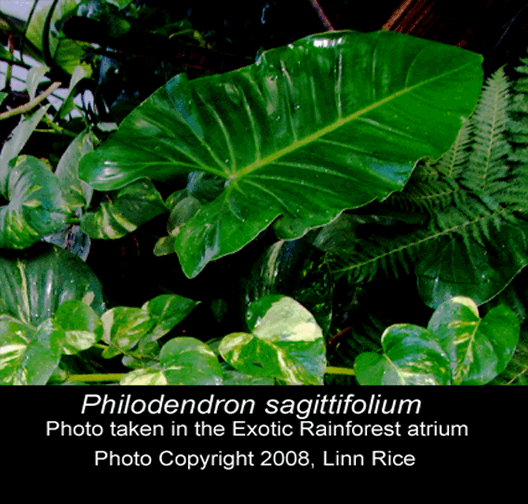
Philodendron sagittifolium
Liebm.
Synonyms:
Philodendron tanyphyllum,
Philodendron
sanguineum,
Philodendron
lancigerum, Philodendron tuxtlanum,
Philodendron daemonum,
Philodendron ghiesbrechtii
Made up name:
"Philodendron mandaianum"
This name is not scientific but was once used in a garden text.
No such species exists in science.
Sometimes referred to as Philodendron x mandaianum, also an invalid name.
Philodendron
sagittifolium is found in nature from Mexico to Colombia, Venezuela,
parts of the Guiana Shield as well as in Ecuador, Peru and portions of
Bolivia and Brazil. Typically, the species is found near
sea level to elevations as high as 1800 meters (approximately 5500
feet). It is considered the most morphologically variable
and ecologically versatile species in Central America. In most
of Central America it can be found in tropical forests and
pre-mountainous wet rain forests.
Philodendron
sagittifolium is normally a hemiepiphytic climbing vine and is
rarely terrestrial or epilithic. A hemiepiphyte
*hem-a-EPA-fite) is a plant that can
begin life from a seed on the ground but also as a seed placed by a bird
on the branch
 of a tree in its droppings (an epiphyte). An epilithic species is
one capable of growing attached to stone. The plant is an appressed
climber growing quite close to the host tree with internodes that are
terete (round) and roots that are a reddish brown. The leaf blades may
be ovate to triangularly ovate (triangular to slightly oval) and are
semi-glossy as well as moderately coriaceous. The botanical term
coriaceous simply means "leather like". Those blades may also be weakly
to moderately bicolorous which indicates the leaf blade is not always a
single color. The sinus of the leaf, which is the area between the upper
leaf lobes is "V" shaped but the lobes may almost close together.
of a tree in its droppings (an epiphyte). An epilithic species is
one capable of growing attached to stone. The plant is an appressed
climber growing quite close to the host tree with internodes that are
terete (round) and roots that are a reddish brown. The leaf blades may
be ovate to triangularly ovate (triangular to slightly oval) and are
semi-glossy as well as moderately coriaceous. The botanical term
coriaceous simply means "leather like". Those blades may also be weakly
to moderately bicolorous which indicates the leaf blade is not always a
single color. The sinus of the leaf, which is the area between the upper
leaf lobes is "V" shaped but the lobes may almost close together.
In 1997 a friend brought me a "house plant" taken from a private botanical park which had been destroyed. I had personally seen the parent of the plant inside that park and recalled reading the name posted on a plaque but could not recall that name. That visit was prior to 1992. It was definitely a Philodendron, but my friend knew little else about the plant species. My friend was a grounds keeper for Metro-Dade County in Miami, FL and had been placed in charge of the abandoned property that was formerly Orchid Jungle Park. Orchid Jungle was at one time a magnificent place to wander through a "rain forest" and see rare and exotic plants as well as hundreds upon hundreds of blooming orchids. The place was so much a jungle it even had monkeys running loose in the trees! That park had been operated by botanists as a private enterprise and the owners had made a great effort to correctly identify their species.
Orchid Jungle was devastated by Hurricane Andrew in 1992 and it's buildings and most of it's plants were literally blown away. This cutting was a survivor of Andrew's wrath and I later secured permission to "rescue" anything possible from the property. Shortly afterwards, the entire property was leveled by bulldozers.
The plant was slow to grow when first planted but soon
began to climb a tree on our property in the southern part of Miami.
But as
much as I tried, I could not find out what the proper scientific name
was for the species. When we began to
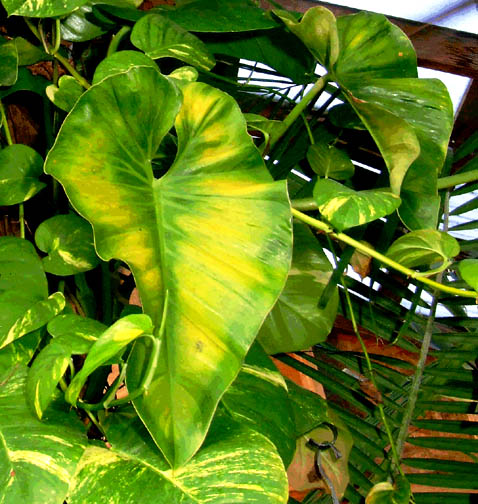 prepare
to move to Northwest Arkansas I elected to leave the plant but took
another cutting. That cutting was planted on the south side of the
center post of our Exotic Rainforest and did it begin to grow! In 3
years it's leaves hit their current maximum size of approximately 70cm
(28 inches) and it has shot up the post to a height of 300cm (10
feet). Today in 2008 the plant has climbed to a height of
almost 17 feet! But I until recently I still did not know it's name despite having given cuttings
to a number of botanist and plant collector friends in an attempt to get
a proper ID.
prepare
to move to Northwest Arkansas I elected to leave the plant but took
another cutting. That cutting was planted on the south side of the
center post of our Exotic Rainforest and did it begin to grow! In 3
years it's leaves hit their current maximum size of approximately 70cm
(28 inches) and it has shot up the post to a height of 300cm (10
feet). Today in 2008 the plant has climbed to a height of
almost 17 feet! But I until recently I still did not know it's name despite having given cuttings
to a number of botanist and plant collector friends in an attempt to get
a proper ID.
Finally, in the Spring of
2005, I acquired several Philodendron species from Central
America, and one soon revealed itself to apparently be this same plant.
The grower had identified it as "Philodendron mandaianum".
I later learned the name "Philodendron mandaianum" was a creation of a
book often used by tropical plant collectors by A. B. Graf known as
Tropica. The name has never been published as a scientific name.
Mr. Graf's book unfortunately contains many errors including "made-up"
and improperly indentified species filled with botanical errors but the current
publishers seem to refuse to update the inaccurate information.
Mr. Graf did a service to collectors by publishing his
text many years ago, however he was not a botanist but instead was
a horticulturist and plant collector. It is unfortunate but many disagreements
regarding the names of plant species arise on the internet
as a result of errors published within his text. Botanists
often point out non-scientific names that can be found in that text in
error. Although a wonderful "picture guide", scientific names
in that text should not be relied on without verifying it in a scientific
source such as
The International Plant Names Index,
TROPICOS,
or the
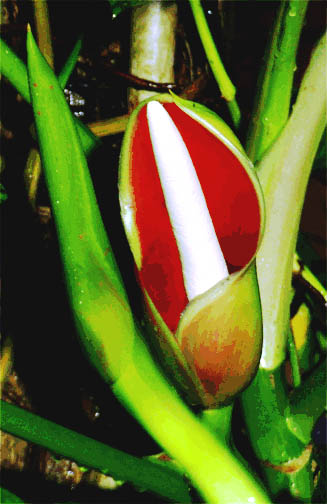 During the summer of 2005
my parent plant finally produced a very short lived inflorescence
(bloom), a lovely large spathe with a red center. A photo of
that inflorescence along with a photo of the plant was sent back to
Central America where it was incorrectly identified by the grower
as "Philodendron mandaianum". I finally thought I knew what I was growing
but
that "discovery" was only to be short lived.
In May of 2006 I began to
receive email regarding this plant from a knowledgeable grower in
Central Florida. The grower/collector was Russ Hammer. He didn't
question my identification but he did bring some news to my attention
which made me begin to question that identification. So I finally
turned to one of the best botanists in the country, Dr. Tom Croat of the
Missouri Botanical Garden, for a clarification. The
Central American grower had his plant misidentified as do likely
hundreds of growers as a result of one of Mr. Graf's books. Dr. Croat pointed
out that "Philodendron mandaianum" was not a published, or recognized
scientific name! He called it simply a "made-up" name.
During the summer of 2005
my parent plant finally produced a very short lived inflorescence
(bloom), a lovely large spathe with a red center. A photo of
that inflorescence along with a photo of the plant was sent back to
Central America where it was incorrectly identified by the grower
as "Philodendron mandaianum". I finally thought I knew what I was growing
but
that "discovery" was only to be short lived.
In May of 2006 I began to
receive email regarding this plant from a knowledgeable grower in
Central Florida. The grower/collector was Russ Hammer. He didn't
question my identification but he did bring some news to my attention
which made me begin to question that identification. So I finally
turned to one of the best botanists in the country, Dr. Tom Croat of the
Missouri Botanical Garden, for a clarification. The
Central American grower had his plant misidentified as do likely
hundreds of growers as a result of one of Mr. Graf's books. Dr. Croat pointed
out that "Philodendron mandaianum" was not a published, or recognized
scientific name! He called it simply a "made-up" name.
That name does appear in some collector's texts but only as a hybrid Philodendron. The name does not appear on a single scientific database! But Dr. Croat did offer an expert opinion of the actual name of the plant based solely on a photo of the leaf blade: Philodendron smithii Engler. The problem was, I failed to show Dr. Croat a photo of the spathe and spadix, only the leaf blade. That was a major error on my part since the species is highly variable. You can see the effects of variation in the comparative illustratoin below. Every photo in that group was taken of a single speciemnt.
Once I finally presented Dr. Croat with a the photo of the spathe and spadix along with a photo of the leaf blade over one year later the identification was clarified. This is the email note I received from Tom,
"I would say that they are both likely to be Philodendron sagittifolium, a widespread and common species." So I pulled out Dr. Croat's Annals of the Missouri Botanical Garden, 1997, Volume 84, #3. In the back of that journal is a black and white photo that is extremely close to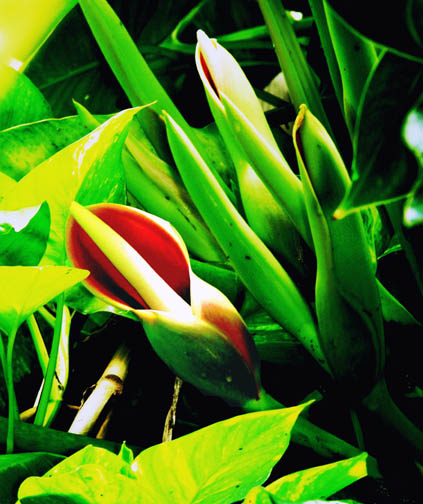 matching the photos of my plant's spathe! I asked again if this was a
variable species identified as Philodendron sagittifolium.
and Tom confirmed it was in fact just that.
matching the photos of my plant's spathe! I asked again if this was a
variable species identified as Philodendron sagittifolium.
and Tom confirmed it was in fact just that.
The spathe in this photo (June, 2008) is approximately 20cm (8
inches) in height. That cluster opened on April 5, 2010. A cluster of
three additional spathes of the
same size formed on the side of this one but none were never open at
the same time.
Originally described to science in 1849, Philodendron sagittifolium has
been observed to be an extremely variable species.
Natural variation is extremely common within aroids. As a result,
it has gained quite a list of synonyms. In botany, a synonym is simply
another name given to the same species but at a later date. Unless a
substantial error can be demonstrated in the original description, the
first name and description become the basionym or base name. All others
become synonyms (Same plant, other name.) The basionym is the
original name applied to the taxon: "basio-" from the Latin: "basis"
from the Greek "bainein", meaning "step", and "-nym" from the Latin
"nomen" meaning "name". It is the first step in the naming process. In
many instances the genus was found to be synonymous but had the
incorrect genus placement.
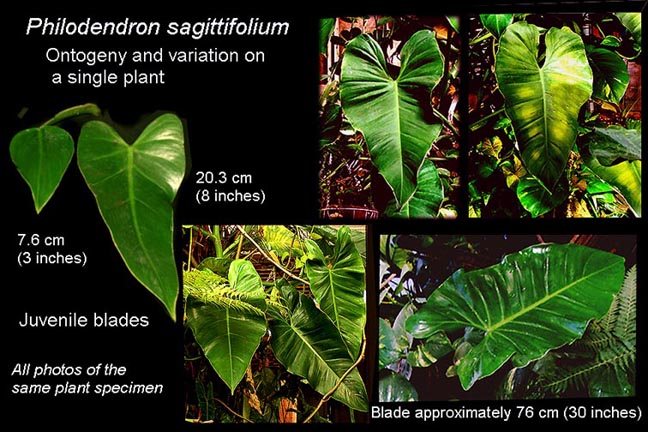
Philodendron sagittifolium normally grows as a hemiepiphytic Philodendron sp. In that case, the specimen will eventually grow long roots extending all the way to the soil. This species is not found to grow on the ground and if so, only rarely. The petioles range from an average of 20 to 65cm (9 inches to 26 niches) in length but have been observed at over 90cm (3 feet) long.
Philodendron sagittifolium is often very difficult to place a positive identification upon. As is evidenced by all the names botanists have attempted to give the species, it is has many shapes and forms. Many people have difficulty understanding the concept of variableness in plants. The expectation is all leaf blades must look alike. Simply put, think of all your friends. I'd guess you have friends with all sorts of body sizes and shapes. You likely know people with many skin colors as well. But all are a single species, Homo sapiens. Human beings. Plants can often be the same way. Leaves within a species do not always look exactly alike!
Within many species you'll find leaf blades that are "fatter" than others, or "taller" than others, or perhaps, even "shorter" or "skinnier" than others. That is exactly what complicates giving a positive identification to this species.
All Philodendron species are aroids. An aroid is a plant
that reproduces by growing an inflorescence known to science
as a spathe and spadix. Some believe the spathe is a
"flower" which is incorrect, te spathe is a
modified leaf. When an aroid is referred to as "flowering" the
reference is to the very small flowers found on the spadix
when the plant is ready to reproduce and has nothing to do with the spathe. Within the
fertile inflorescence there are extremely small flowers found
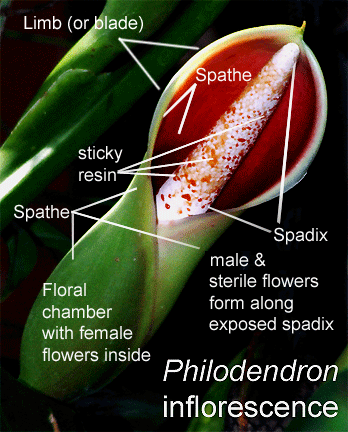 on the
spadix during anthesis (sexual reproduction). When ready to
be pollinated the spadix produces male,
female and sterile flowers and if the female flowers are at
female anthesis they may be pollinated with pollen brought by an appropriate
Cyclocephala beetle from another plant which is at male
anthesis. The reddish resin on the spadix sticks to
the body of the beetle and causes the pollen (which is a source of
protein containing food for the beetle) to be carried to another
specimen. Once pollinated, the spadix will produce berries containing seeds.
The female flowers are hidden from view inside the floral chamber at the
bottom of the spathe in Philodendron species.
on the
spadix during anthesis (sexual reproduction). When ready to
be pollinated the spadix produces male,
female and sterile flowers and if the female flowers are at
female anthesis they may be pollinated with pollen brought by an appropriate
Cyclocephala beetle from another plant which is at male
anthesis. The reddish resin on the spadix sticks to
the body of the beetle and causes the pollen (which is a source of
protein containing food for the beetle) to be carried to another
specimen. Once pollinated, the spadix will produce berries containing seeds.
The female flowers are hidden from view inside the floral chamber at the
bottom of the spathe in Philodendron species.
The inflorescences of Philodendron sagittifolium are erect and the plant can produce one or more inflorescences per axil. However, the color of the spathe may be variable and may not match the photo on this page exactly. The peduncle, which is the plant structure that supports the spathe, normally measures 4 to 5cm long (1.5 to 2 inches). The spathe is somewhat flattened and green, but is often tinged with red on the inside. The spathe normally measures 8 to 22cm (3.2 to 8.7 inches) in length but the spathe can be variable. A peduncle is the internode between the spathe and the last foliage leaf. We have observed the spathe to be narrow at the center but that does not always occur. We have also observed tubular spathes on the this species.
Philodendron sagittifolium can produce an inflorescence almost any time of the year, but normally after the beginning of the dry season and continuing throughout most of the rainy season. We typically see the spathe and spadix in our artificial rain forest in May and June of each year. In nature, there is a slight shift based on geography with "flowering" beginning about one month earlier in Mexico and Guatemala (late winter) but less frequently in September and October. Inflorescence production continues longer in Panama and is seen in February through September and has rarely been observed in December. The fruits take approximately two months to mature. However, in our atrium, we do not have any natural pollinators (beetles) present to service this species so we have never observed the development of fruit.
Philodendron sagittifolium is a member of Philodendron section Calostigma subsection Macrobelium series Macrobelium. The species was published to science in Videnskabelige Meddelelser fra Dansk Naturhistorisk Forening i Kjøbenhavn in 1849. P. sagittifolium is the basionym (base name) for numerous synonyms of the species and is currently the accepted scientific name. The species is highly variable and takes on many leaf shapes as can be seen by the list of synonym species above, it is known by a large variety of now incorrect names. The species is common in Central America.Philodendron. sagittifolium is a member of Philodendron section Calostigma subsection Macrobelium ser. Macrobelium. One synonym, Philodendron lancigerum appears to be a narrow leaf form of Philodendron sagittifolium. That form is restricted to the Pacific low lands of Costa Rica.
Want to see the inflorescence of Philodendron sagittifolium go through anthesis? Click this link.
Want to learn more
about aroids?
Join the
International Aroid Society:
http://www.exoticrainforest.com/Join%20IAS.html